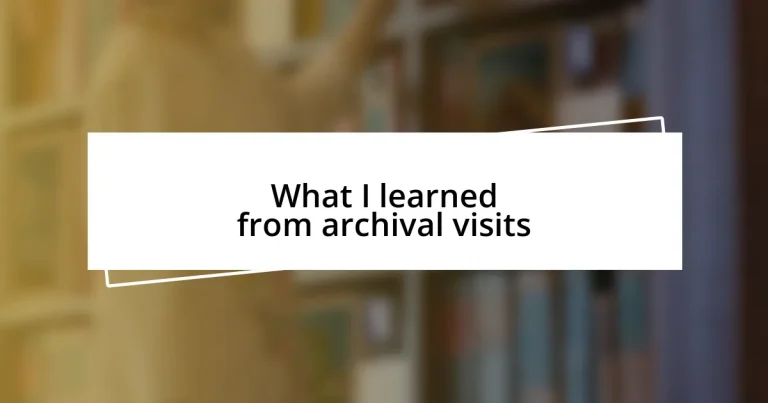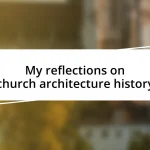Key takeaways:
- Conduct thorough background research prior to an archival visit to enhance focus and purpose.
- Engage actively with archivists and staff to uncover unique insights and hidden treasures within collections.
- Document findings effectively using a combination of handwritten notes and digital tools to facilitate retention and sharing.
- Reflect on the emotional impact of discoveries to deepen personal connections to historical narratives.
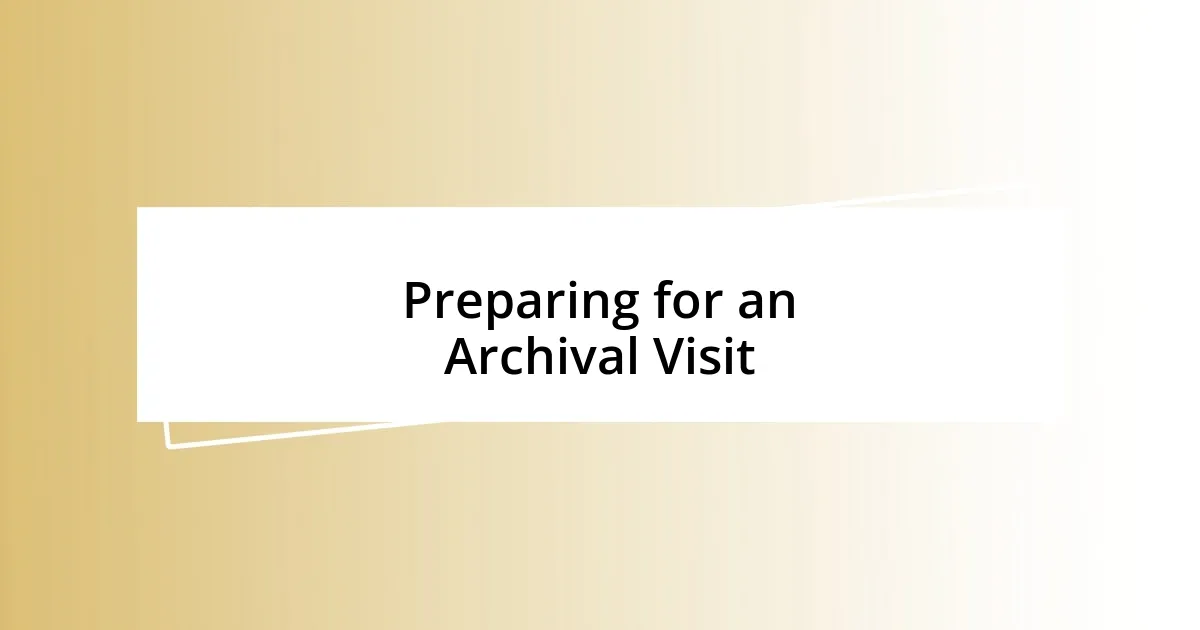
Preparing for an Archival Visit
When gearing up for an archival visit, one of my key approaches is to dive deep into background research first. I remember the flutter of excitement I felt when I uncovered the history of my great-grandfather, only to realize I was fumbling through the stacks like a novice. Why not spend a little time prior to your visit getting to know key dates, names, and events? It transforms the experience from wandering to purposeful exploration.
I always pack a notebook and a few pens, which may seem mundane, but trust me—being ready to jot down thoughts is essential! On one occasion, I forgot my materials and lost precious insights as I sifted through documents. It taught me that the physical act of writing helps me connect with the information at a deeper level. Have you considered how you might best capture your thoughts during your visit?
Lastly, don’t underestimate the power of reaching out to the archivists beforehand. The warmth in their voices and willingness to help can set the tone for your entire experience. I’ve found that a simple email asking about specific collections opens doors I didn’t even know existed. What insights could you gain by engaging with these knowledgeable individuals ahead of time?
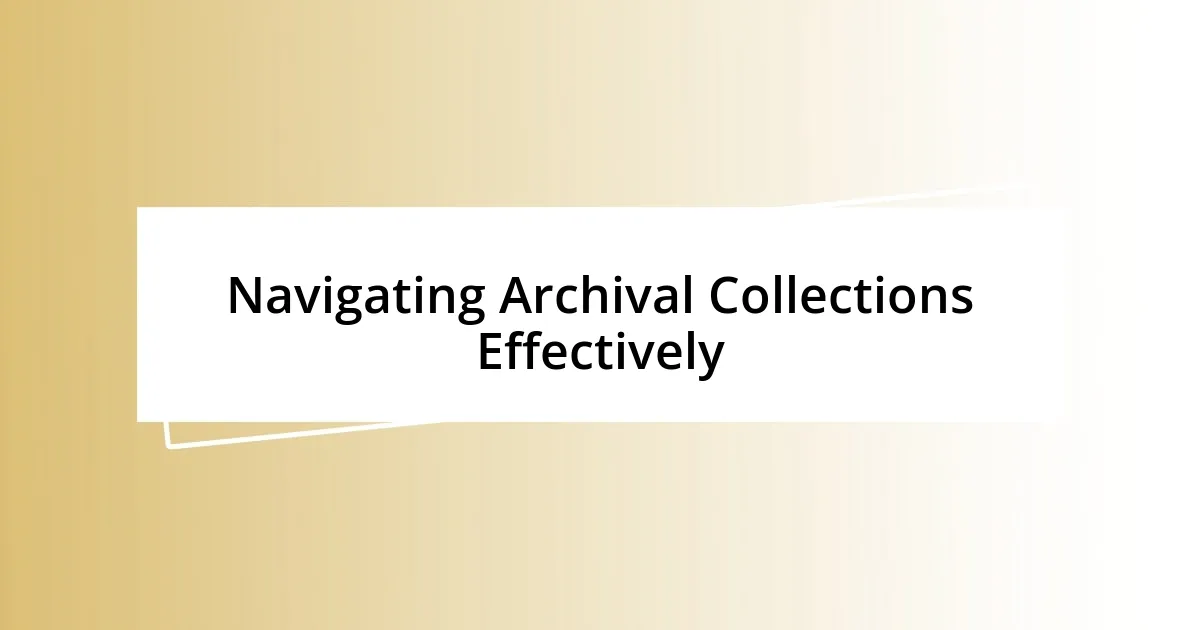
Navigating Archival Collections Effectively
Honing in on techniques for navigating archival collections can make all the difference in your research experience. During one of my visits, I discovered that focusing on a handful of key subjects rather than overwhelming myself with everything at once allowed me to dive deeper into the material. I felt the thrill of uncovering details that tied my family’s narrative together, and it became clear that being selective is essential for contextual understanding.
To help you navigate archives effectively, consider these tips:
- Create a Research Plan: Outline specific topics or names you want to focus on. This keeps your efforts streamlined.
- Use Finding Aids: Familiarize yourself with these guides that list collections and their contents, making explorations more directed.
- Set Time Limits: Allocate time per topic or collection to avoid burnout and ensure a comprehensive overview.
- Take Breaks: Step away periodically to reflect on what you’ve gathered. This allows insights to surface that you might miss in a continuous push.
- Engage with Staff: Don’t hesitate to ask archivists for pointers or recommendations; their expertise can reveal hidden treasures.
I find that utilizing these strategies not only enhances my efficiency but also enriches my emotional connection to the materials. It’s fascinating how a simple shift in approach can transform archival visits from daunting tasks into exciting journeys of discovery.
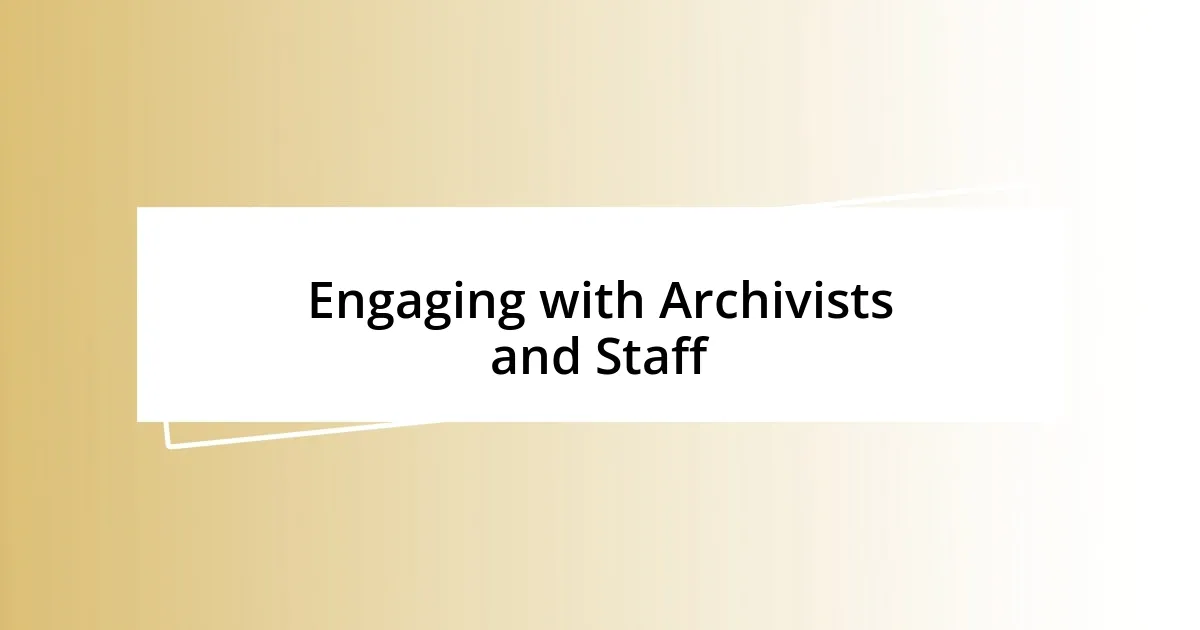
Engaging with Archivists and Staff
Engaging with archivists and staff is truly one of the highlights of a visit. Their enthusiasm for the collections often mirrors your own, creating a shared excitement that can ignite your research journey. On one visit, I struck up a conversation with an archivist who shared intriguing lesser-known stories about a collection. Her insights transformed my understanding and led me to pursue avenues I hadn’t even considered. It’s amazing what you can learn just by expressing genuine curiosity.
I’ve also found that building rapport with the staff can be surprisingly rewarding. When I approached them with specific questions about my research, the look of joy on their faces was palpable—like they were welcoming me into a special club of history enthusiasts. It reminds me that behind every document are passionate individuals ready to share their wealth of knowledge. Have you ever wondered how many stories remain untold simply because researchers fail to connect with the people who hold the keys?
Through my experiences, it’s clear that archivists are not just gatekeepers; they are invaluable guides on our exploration of the past. A thoughtful interaction can lead to personalized recommendations that might otherwise go unnoticed. Next time you enter an archive, try to see these staff members not just as sources of information but as partners in your research adventure. Their perspective can uncover the rich tapestry of narratives woven through the documents.
| Engagement Method | Benefit |
|---|---|
| Asking Questions | Gathers unique insight and information |
| Building Relationships | Creates deeper engagement with the material |
| Seeking Recommendations | Reveals hidden treasures in the collection |
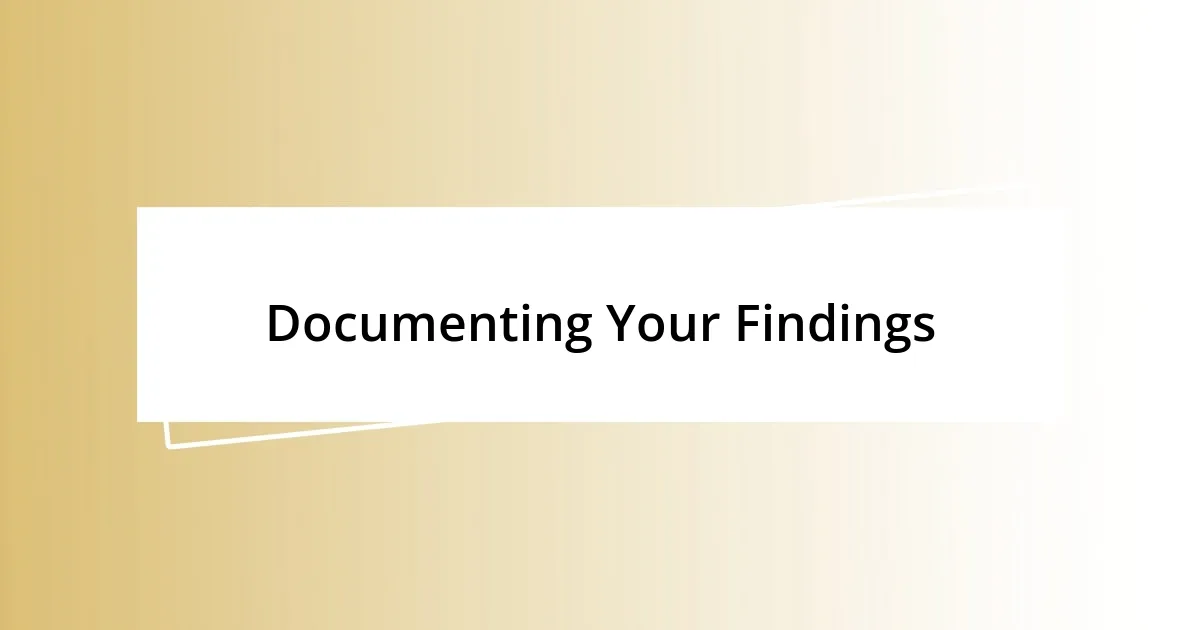
Documenting Your Findings
Documenting findings during archival visits is a critical step in preserving the insights and connections you make. After each visit, I take a moment to reflect on what I’ve learned and jot down my impressions in a dedicated notebook. This practice not only helps me retain vital information but also allows me to express my thoughts and feelings about the material. Have you ever noticed how the act of writing can solidify your understanding and spark new ideas?
One method I find effective is keeping a detailed log of specific documents and their relevance to my research. For instance, during one visit, I discovered a letter that shed light on my great-grandmother’s life during a challenging period. I made sure to note its location, context, and even my emotional response to reading it. This way, I can revisit those moments later and remember why they mattered to me. Isn’t it fascinating how a single piece of paper can reconnect us to our roots?
Finally, I also recommend utilizing digital tools to enhance your documentation process. After sorting through piles of documents, I quickly type up my notes on my laptop or tablet, often adding scanned images of the documents I found impactful. This hybrid approach—combining handwritten notes with digital records—provides a comprehensive view of my discoveries and allows for easier sharing with others. Have you thought about how technology can streamline your archival experiences while keeping the personal touch alive?
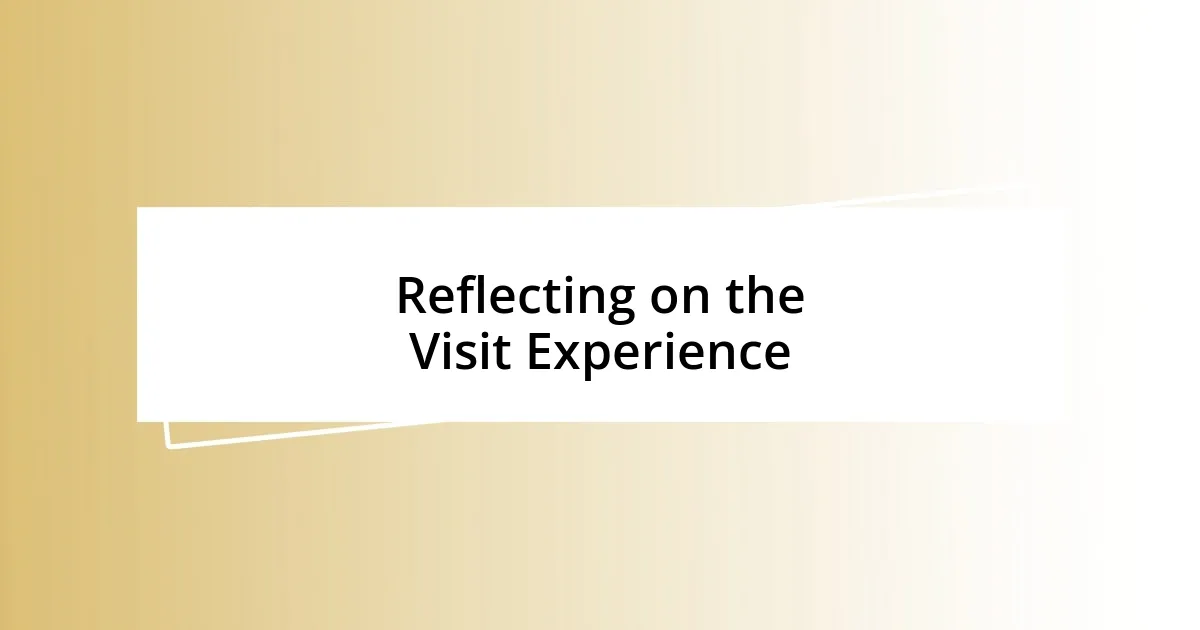
Reflecting on the Visit Experience
Reflecting on my archival visits always brings a wave of emotions. Each time I step into a new space filled with historical documents, I feel a tangible connection that transcends time. On one particular visit, as I sifted through an old photograph album, I could almost hear the laughter of the people captured in those fading images. Isn’t it incredible how a photograph can awaken memories not just for the individuals in it, but also for those of us exploring those stories decades later?
The quiet hours spent in an archive often lead to profound moments of self-discovery. I recall feeling a mix of excitement and anxiety as I dug into letters written during a tumultuous period in history. Each phrase seemed to speak directly to me, bridging the gap between my own experiences and those from the past. Have you ever experienced that moment when the lines of history blur, and you realize that our emotions—joy, sorrow, hope—are truly universal across time? It was during that visit that I understood history is not just dates and events; it’s about the human experience.
After a meaningful visit, I’ve learned to take a step back and process what the experience truly means to me. I often sit down with a warm cup of tea, reflecting on the connections I forged and the insights gained. It’s a ritual that brings clarity and allows me to appreciate the journey. What did I learn about myself? How will these discoveries influence my research moving forward? Sometimes, it’s these moments of quiet reflection that provide the deepest insights.
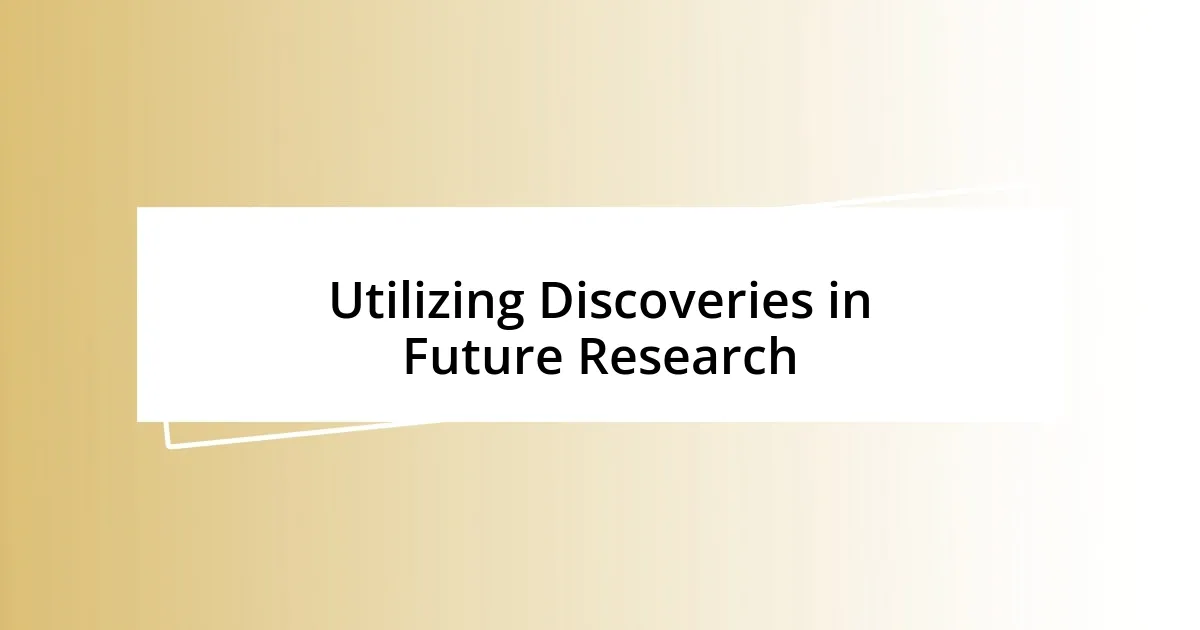
Utilizing Discoveries in Future Research
Utilizing the discoveries I make during these invaluable archival visits often feels like unearthing treasure. Just the other day, I came across an unassuming ledger that documented community activities from the early 1900s. As I read through the meticulous entries, I was struck by the shared aspirations and struggles that mirrored my own community today. How often do we overlook the lessons from history that can guide our present? That ledger became a vital reference for an upcoming research project on community resilience, reinforcing the idea that our past truly informs our future.
I’ve found that integrating these findings into my work is an adventure in itself. Take the handwritten diary I stumbled upon during a visit; it told the story of a woman navigating societal expectations in her lifetime. I decided to quote her reflections in my thesis, weaving them into my argument to give voice to her experiences. This approach not only enriched my analysis but also made the research feel more alive and relatable. Isn’t it remarkable how a primary source can transform the narrative you’re trying to build?
Going forward, I’ve realized the importance of continuously revisiting my discoveries. I often create thematic folders on my computer where I save images, transcriptions, and notes from my visits. Each time I dive back into these resources, I find new connections or gain deeper insights that sharpen my research focus. How can we ensure that our findings don’t fade away after the initial thrill of discovery? For me, it’s about revisiting, rethinking, and allowing those moments to inspire new questions and directions in my ongoing studies.












